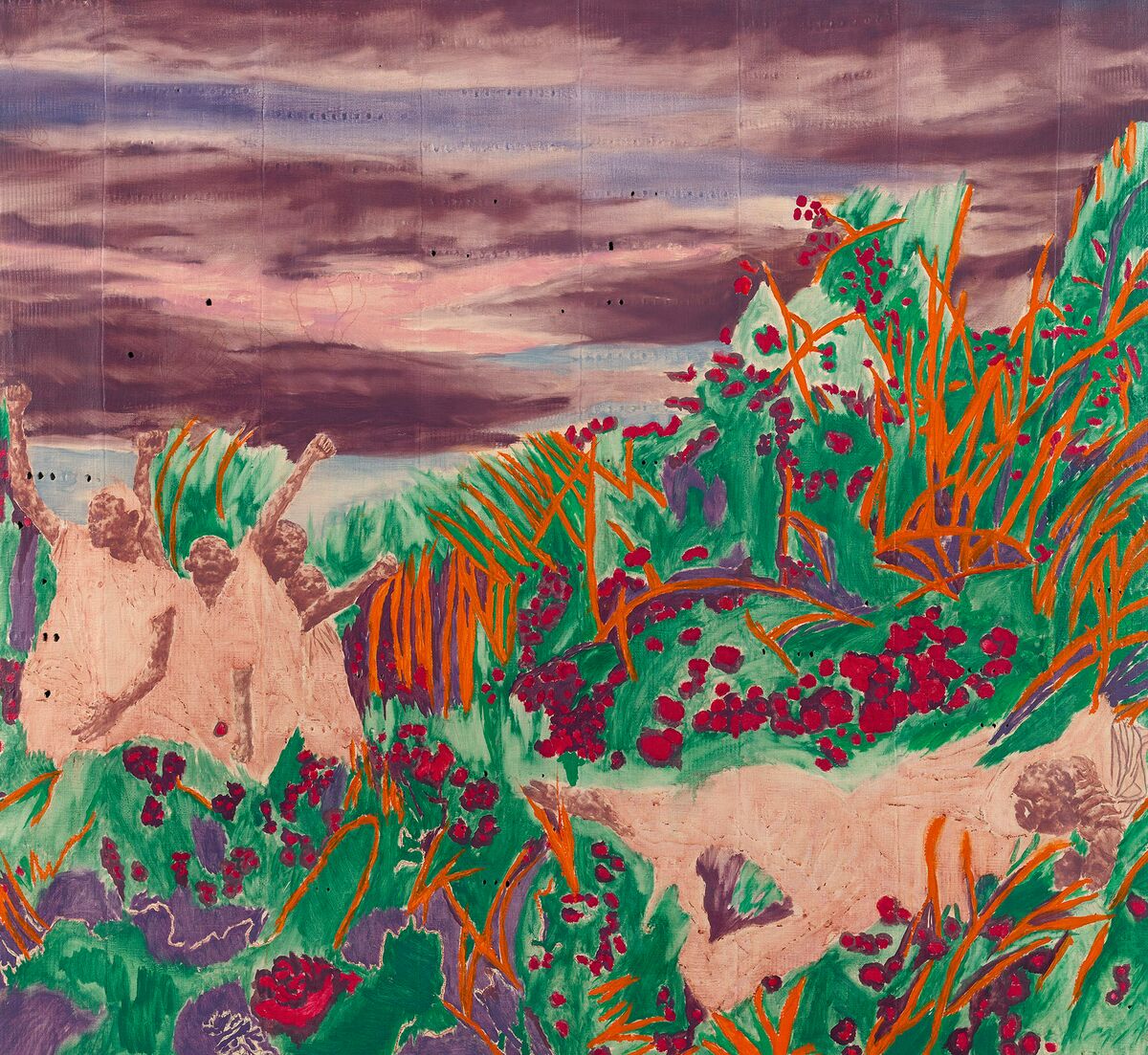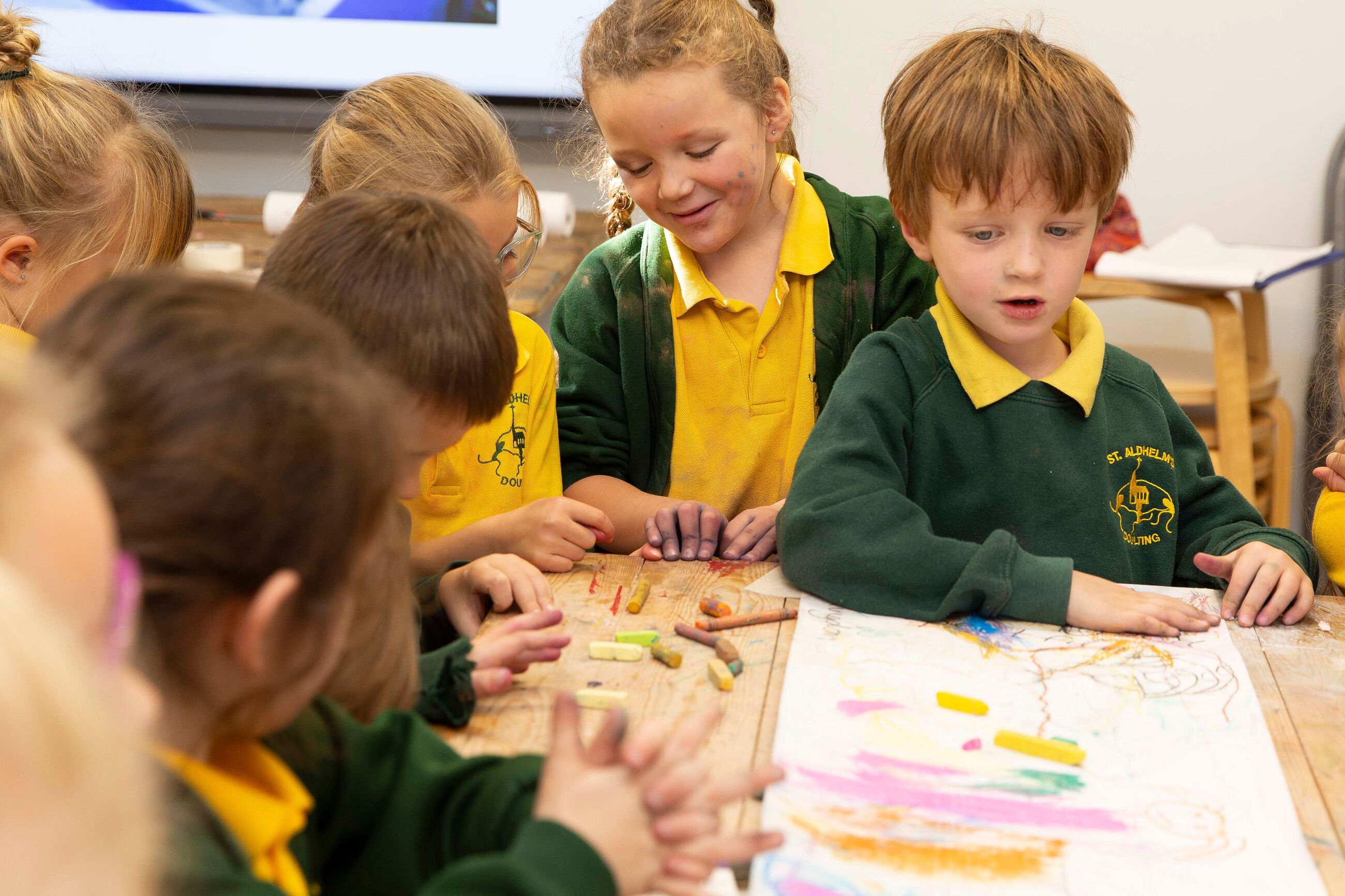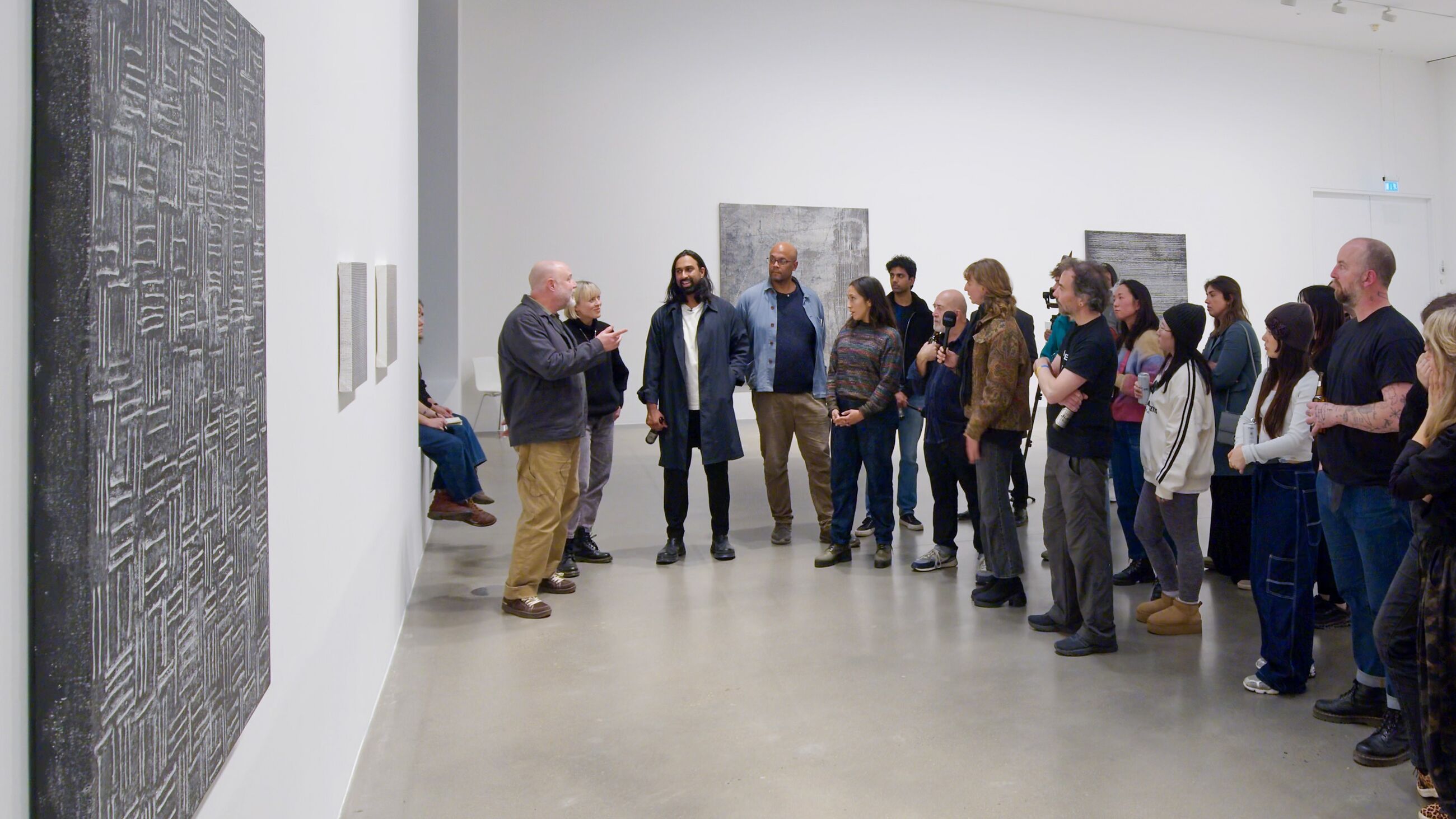Exhibition Learning Notes: ‘George Rouy. The Bleed, Part I’

Studio view George Rouy, 2024 © George Rouy. Courtesy the artist and Hannah Barry Gallery. Photo: Damian Griffiths
Exhibition Learning Notes: ‘George Rouy. The Bleed, Part I’
This resource has been produced to accompany the exhibition ‘George Rouy. The Bleed, Part I’ at Hauser & Wirth London from 7 October – 21 December 2024.
Click here to download a PDF version of this resource.
About George Rouy
British artist George Rouy’s dynamic and signature use of the human figure, vexed with desire, alienation and crisis, speaks to the extremities of our time; portraits of identity in a globalized and technologically driven 21st Century. Rouy (b.1994) lives and works in Faversham, Kent. Since graduating from Camberwell College of Arts, he has exhibited internationally, including: ‘Present Tense,’ Hauser & Wirth Somerset, UK (2024); ‘The Echo of Picasso,’ Museo Picasso, Málaga, Spain; ‘Endless Song,’ Nicola Vassell Gallery, New York NY (2023); ‘BODY SUIT,’ Hannah Barry Gallery, London, UK (2023); ‘Belly Ache,’ Almine Rech, Paris, France (2022); ‘Real Corporeal,’ Gladstone Gallery, New York NY (2022); ‘A Thing for the Mind,’ Timothy Taylor Gallery, London, UK (2022); ‘Shit Mirror,’ Peres Projects, Berlin, Germany (2022); ‘Rested,’ Nicola Vassell, New York NY (2021); and ‘Clot,’ Hannah Barry Gallery, London, UK (2020).
His work is represented in the collections of The ALBERTINA Museum and The Albertina Modern, Vienna, Austria; ICA, Miami FL; Fondation Cartier pour l’art contemporain and Lafayette Anticipations, Paris, France; Stahl Collection, Norrkoping, Sweden; M Woods, X Museum and 69 Art Campus, Beijing, China; and Sifang Art Museum, Nanjing, China.
The first monograph of his work, ‘George Rouy / Selected Works 2017 –2023’ with an introductory essay by Charlie Mills, was published by Tarmac Press in 2023. The live creation, ‘BODYSUIT,’ with choreographer Sharon Eyal and original music composed by Rouy, premiered at Hannah Barry Gallery, London, UK in 2023.
What does the exhibition look like?
The exhibition contains a new body of work by the artist, continuing his inquiry into collective mass, movement and human modes of existence. A collection of mostly large-scale paintings utilising oil and acrylic on canvas and linen along with new experimental monochrome works in charcoal and silver pigment, termed ‘phantom paintings’ by the artist, are displayed for the first time. Group scenes and collectives of figures are represented throughout the exhibition. These figures mass together and create the sensation of an internal rhythm and energy. No face, portrait or specific identity is obvious as they all seem to disintegrate and morph into and out of each other. In addition to the large-scale paintings, two small-sized blurred portrait paintings are included in the exhibition. The unidentified faces in these paintings create a sense of intimacy, as they may be perceived as a reflection of the viewer’s own face. How these figures compositionally interact with each other, the space around them and by extension the viewer, is a key element of the exhibition.

Installation view, ‘George Rouy. The Bleed, Part I,’ Hauser & Wirth London, 2024 © George Rouy. Courtesy the artist andHannah Barry Gallery. Photo: Damian Griffiths
How does he make his work?
Rouy utilizes found images and material discovered on the internet as sources of inspiration for his work. Often these visual prompts will provoke a mood or certain emotion which he then develops into a series of paintings. His initial starting point often consists of mark making and gestural work in oil paint and acrylic on canvas, done on impulse, from which his abstract figures eventually emerge. Alternatively, initial compositional ideas can start life on his computer with the artist then transferring concepts to canvas. As work progresses, he photographs it and then uses Photoshop to explore further compositional structure and color tones.Charging his paintings with energy and a sense of vibration is a key concern for Rouy and music is a notable feature of his studio practice.
‘I love every type of music. I find it very hard even walking down the street without music. I get quite sensitive and overwhelmed just walking, so music focuses me— especially when you are painting.’—George Rouy
An example of Rouy’s concept of ‘bleed’ can be seen in the painting ‘Formless Being’ (2024).A fleshy mass of figures congeals together, yet their extremities seep and blend into the canvas that surrounds them. Gender and other typical identifiers such as portraiture are deliberately omitted or blurred. It is only the rendering of hands that appear more clearly delineated within the overall composition as they are devices used by the artist to move the viewer’s eye around the canvas and interlink different compositional elements within the painting.

George Rouy, Formless Being, 2024 © George Rouy. Courtesy the artist and Hannah Barry Gallery. Photo: Damian Griffiths
What are his sources of subject matter?
The human body is a constantly recurring subject for the artist. It is important to recognize however, that the forms depicted and the way a viewer may read them, are never autobiographical for Rouy. He prefers more open-ended interpretation and engagement with the figures he paints and the concepts that can be inferred from them.
‘I think it is important that they are not autobiographical. There needs to be enough space so that the viewer can enter it and not just assess it as these stories, because they are not stories. They are almost like symbols.’—George Rouy
Human emotions and experiences (both individual and collective) are other important sources of subject matter for the artist, particularly internalised thoughts, behaviours and social experiences that can offer insights into what it means to be human in the current age. Dance is an art form that regularly is a source of inspiration and subject matter for the artist and which he often references in relation to his own painting.
During his most recent solo exhibition, ‘BODY SUIT,’ Hannah Barry Gallery, London, UK (2023), Rouy and leading choreographer Sharon Eyal presented their first joint creation. The outcome of their combined perspectives was a unique, visionary live event with exacting, rigorous, and yet liberated practices in movement, light, sound and environment. ‘BODYSUIT’ will be expanded to a full-length live piece, premiering in London in late 2024.
‘With dance you can understand movement like the tightening of bodies or the opening of the body, you can almost link it to emotions and link it to your own body, so when I am thinking about painting, I want the viewer to almost feel the same, almost embody the poses or essence of the paintings.’—George Rouy
What are the major themes within the exhibition?
A concept of ‘carrying’
A core theme within the exhibition is the concept of ‘carrying’ which for the artist refers to how an individual experiences life from birth to death and what forms of physical, emotional, or societal support one might encounter on this journey, or not. The paintings provoke questions around societal collective care within a rapidly changing world.
Human identities in the digital age
The way social media and digital technologies have now enabled a reality in which people’s identities and lived experiences are no longer confined to our physical bodies but have ‘bled out’ into the world wide web is an important theme for the artist. How we perceive ourselves and others in such a distorted unreality is a question posed through the paintings.
Impacts of a chaotic world on the human condition
How global phenomenon such as climate change affects people at an individual or collective level is another theme within the exhibition. The uncertainty around environmental collapse induces anxiety and stress for many with implications for mental health, wellbeing and the physical body.

George Rouy, Poseur, 2024, © George Rouy. Courtesy the artist and Hannah Barry Gallery. Photo: Damian Griffiths
What artists does his work relate to?
Francis Bacon (1909 – 1992) was an Irish-born British painter who primarily used the human body as a source of subject matter in this work. His paintings are renowned for their emotional intensity and often unsettling imagery.
Cecily Brown (b. 1969) is a British painter and makes paintings that give the appearance of being in continual flux, alive with the erotic energy of her expressive application and vivid color, shifting restlessly between abstract and figurative modes.
Lucian Freud (1922 – 2011) was a British painter who captured the psychological states of the figures and people he represented in paint. The physicality of the body and how such bodies occupied space was a key area of interest in his work.
Theodore Géricault (1791 – 1824) was a French painter associated with the romantic movement of the early 19th Century. His work is renowned for its dynamic compositional arrangements and intense emotions.
Jenny Saville RA (b. 1970) is a contemporary British painter and an original member of the Young British Artists (YBA). Saville works and lives in Oxford, UK, and she is known for her large-scale painted depictions of nude women.
Hauser & Wirth artists to consider
Rita Ackermann’s (b.1968) compositions occupy a space between the figurative and the abstract, where human forms simultaneously disappear and re-emerge.
Catherine Goodman’s (b.1961) intensely expressive painting process uses strongly pigmented oil paint, brushwork, oil sticks, drips and washes to create atmospheric and immersive paintings which explore both figuration and abstraction.
Christina Quarles (b.1985) is a Los Angeles-based artist, whose practice works to dismantle and question assumptions and ingrained beliefs surrounding identity and the human figure. She utilizes bodily experience as her subject creating an artistic engagement with the contradictions inherent in one’s own complex, nuanced identity.
Ambera Wellmann (b. 1982) is known for her technical mastery in oil painting, drawing inspiration from renaissance and baroque styles. Wellmann’s work manifests through irrational pictorial space and the depiction of an indeterminate number of bodies, genders, species, all without any predetermined visual hierarchy.

Installation view, ‘George Rouy. The Bleed, Part I,’ Hauser & Wirth London, 2024 © George Rouy. Courtesy the artist and Hannah Barry Gallery. Photo: Damian Griffiths
Glossary
Androgynous
A blending of both masculine and feminine characteristics that does not correspond to traditional gender norms.
Autobiographical
Something based on personal life and experience.
Choreographer
A person who devises dance and movement sequences for performances.
Fluidity of identity
A concept that explores how a person’s identity such as gender, sexuality and cultural connections are not fixed and can evolve over time and in different contexts.
Found images
Pre-existing images from digital media, books, magazines and other sources that artists incorporate and recontextualise into their own artwork.
Gestural
A manual style or technique used by artists to create energetic and expressive drawings and paintings.
Monochrome
The use of only one color or variations of a shade of singular colours in an artwork.
Romantic movement
A late 18th and early 19th Century movement in the arts that focused on themes of emotion, imagination and the importance of nature as a powerful entity.
Discussion questions
Creating a sense of connection and encouraging self-reflection through bodily awareness between viewer and painting is an important element in Rouy’s practice. What are your initial reactions to his work and what emotions do they evoke for you?
Observe how the artist represents the human body. What do you notice that is different from other artists you might know who work with this subject matter? What messages or themes do you think Rouy might be conveying through his approach?
In a compositional sense, Rouy’s paintings move between figuration and abstraction. In viewing the works do you read any narrative or aspects of storytelling?
Music and performance art often influence Rouy’s painterly practice, do you think this is evident in this exhibition and if so, in what ways?
Supplementary research
File Downloads
Download Exhibition Learning NotesResources
1 / 10









